The Rapid 2010 Show
Bathsheba Grossman Sculptures
SME, the Society of Manufacturing Engineers, sponsors various expositions relating to the design and production of manufactured items in the USA. The Rapid show is dedicated to “Rapid” prototyping (which has morphed into Rapid Manufacturing) as well as 3D scanning technologies and the ancillary software and materials that make it work. This year’s event was held at the Disneyland hotel in Anaheim California on May 18-20, and featured a conference (which I didn’t attend), the trade show, and an art show (in which I participated, along with 19 other artists using this sort of technology to make sculpture of various types.)
The main stars of this show were the additive 3D printers—big-ticket items which make it possible to create physical parts by accretion, building things using various strategies including laser sintering of powders, photochemical curing of polymers, deposition of molten plastics, or printing binders into beds of powder with ink-jet technology. The manufacturers of these machines had the largest booths, and were eager to let everyone know about the latest and greatest improvements to their systems. Just for fun, attendees at this exhibit were encouraged to collect the parts for a toy rocket-ship by going from booth to booth and picking up components which each manufacturer had fabricated, turning the event into a high-tech scavenger hunt. (I collected some parts, but must have missed some, because my rocket never came together…)
Probably the most impressive 3D fabrication machine was Objet Geometrie’s $200k multimaterial printer, which had the ability to print in a variety of materials ranging from hard to rubbery and in various colors including clear, so that parts could be created with soft exteriors and hard interior parts—useful for realistic prosthetics—or clear exteriors through which interior structures could be seen. Printing directly in metals has advanced considerably as well. At this show, EOS of North America introduced new aluminum and nickel materials for its DMLS (Direct Metal Laser Sintering) machines that build up parts by melting metallic powders layer by layer—other metals used include bronze alloys, titanium, tool steel, and stainless.

There was a major RP price breakthrough announced; an ABS printer for under $4k. Based on the open-source RepRap project, the Panther is made by Bits from Bytes in the UK and distributed locally by Purple Platypus, who also sells the Objet printers. I looked at the samples it had built, and while some stratification was evident, it looked a lot like the output from much more expensive RP printers 4 or 5 years ago. It’s a bit coarse, but the amazing thing was that this could be done at all for that price, and with a substantial build volume (11.2″ × 11.8″ × 7.9″). Stratasys had some new offerings as well, their “personal” Dimension uPrint and uPrint Plus FDM (Fused Deposition Modeling) machines, which although considerably more expensive than this, still represent a new low price-point for machines of this type at $15k and 20k respectively. With layer thicknesses of .010″, detail and surface smoothness was considerably better than output of the BFB machine, as one would expect for the considerable difference in price, although the build volumes were smaller. Z-corp, known for its powder-bed printers, was showing off a new system, the ZBuilder Ultra, licensed from another manufacturer, which builds objects by flashing a glass tank of photo-sensitive liquid with layer-images from underneath. The results were smoother and more durable than the objects Z-corp normal machines build from consolidated powder (although they don’t print in full color), and since Z-corp is a much easier company to deal with than the company that developed it, they might have some success with it.
Several of the manufacturers I deal with were there, including Creaform, showing off the Handyscan line of hand-held scanners, capable of unrivaled flexibility in gathering surface information from complex 3D objects. Roland DGA was promoting CNC milling (aka “subtractive rapid prototyping”) with a challenge to users of additive 3D printers: “Can your 3D printer do this?.” The MDX-540 they had running was indeed making objects with surfaces smoother than any produced by the machines of their additive rivals, using solid plastics that were both less expensive and more durable than the costly feedstocks they require. GeoMagic was demonstrating the latest versions of their Studio and Qualify softwares for reverse engineering and inspection; I found the Studio interface quite intuitive for such a powerful piece of software. Rapidform also was present, with their new XOR3 software that enables users to recover “design intent” from a scan of a manufactured product, starting with an imperfect (or worse) scan and building a perfect solid parametric model feature by feature.
Other scanner and digitizer companies were also there, from Faro, which makes articulated-arm devices for precision metrology, including one that mounts a laser head for faster and longer-range image capture (up to 395 feet away) to Konica-Minolta, with the Vivid 9i, a new version of its tripod-mounted big-box non-contact 3D digitizer with interchangeable lenses, which claims the ability to capture detail of +/-.05mm at its closest-range settings. 3D3 Solutions was another interesting exhibitor. Instead of producing a one-size-fits-all 3D scanner, they offer customized scanning solutions which are individually tailored to a client’s needs. For a podiatric application, for instance, they constructed a multi-scanner array which captures a patient’s foot from a number of angles quickly and simultaneously, turning what could have been a tedious ordeal into a quick and simple procedure.
An array of service providers were on hand, from companies like Direct Dimensions offering sculpture scanning and enlargement, to those who specialized in making complicated one-off pieces of military aircraft or producing custom implants in titanium based on someone’s CT scans. There were foundries which leverage rapid prototyping technology to skip the mold-making process, making patterns that could be burned out cleanly and cast using the lost-wax process (InvestCast) or pressed into service for sand-casting (ACTech). And there were several companies, like Metalise-it America, VacuCoat Technologies, and Quaker City Plating which specialized in electo-plating metal onto RP plastic parts; this wasn’t cheap, though, since a lot of hand-finishing was involved if a shiny metal surface was desired. One company, CloudFab, was trying to create an online marketplace for rapid prototyping and manufacturing services where clients could upload a proposed project and get bids from a range of people ready to build it for them, who would pay for the service on a sliding scale, depending on price, if they got the job.
Somewhat surprisingly, the range of exhibitors was not limited to companies selling software, esoteric services, or high-tech gizmos. There were quite a few providers of basic materials and supplies for molding and casting, many of whom I knew from being a sculptor (before going digital). Silicones Inc, Silpak, Smooth-On, and Polytek, suppliers of rubber mold materials; Reynolds Advanced Materials which also sells plaster and cement-based products used to fill molds, and a number of manufacturers of castable plastic materials, mostly urethanes, such as BJB Enterprises, PTM&W Industries, and Innovative Polymers were all there, hoping to catch this new wave of American manufacturing and design.
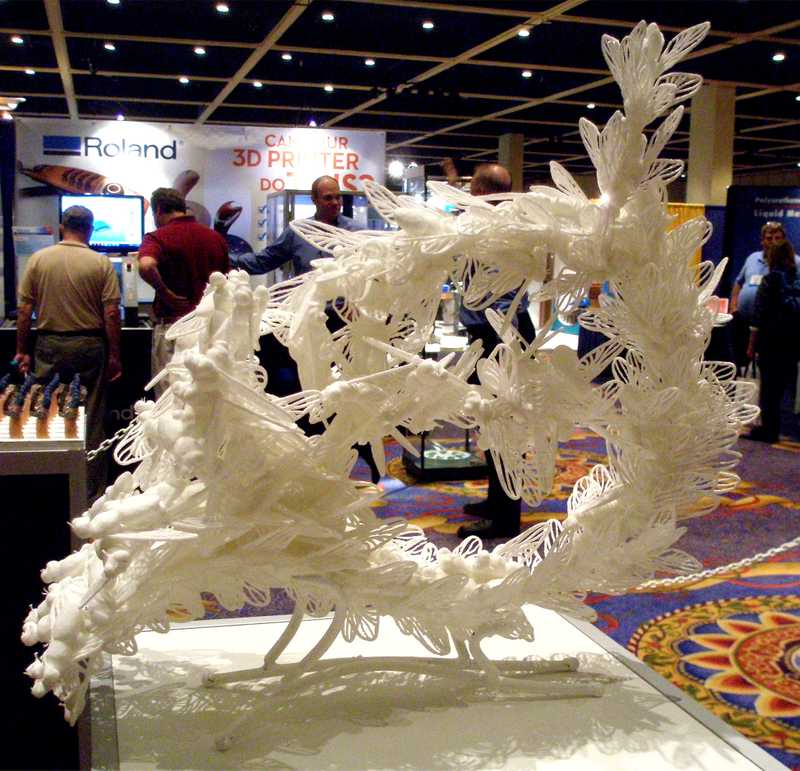
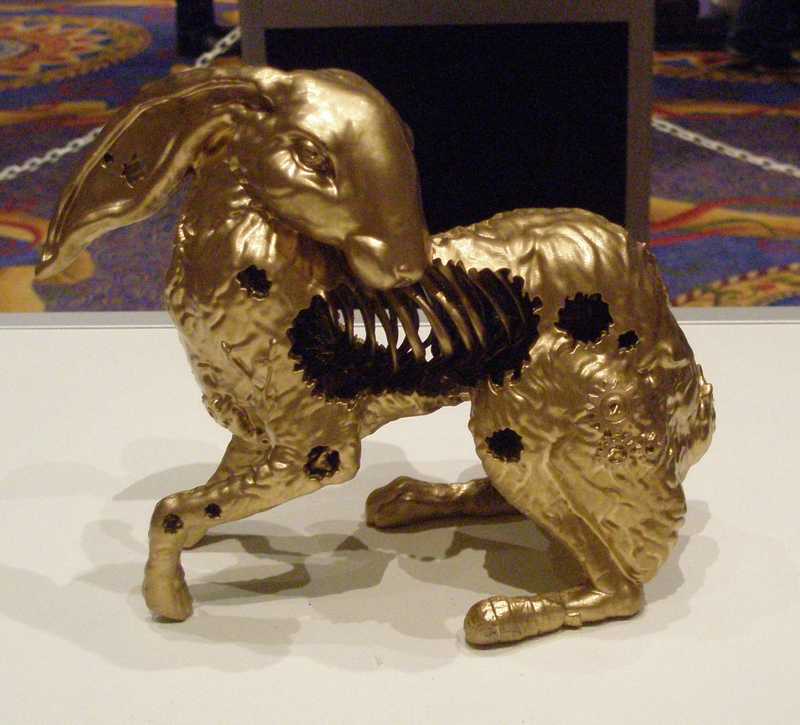
Of course, for me, the hit of the show was the sculpture on display—this was the first year in which this show has featured a Contemporary Art Gallery. Twenty artists (including myself) using various additive techniques to produce something other than industrially-focused parts helped elevate the experience of attending this event to a higher aesthetic plane. Interestingly, more than half the artists in the show, although experienced at making art in various media, were new to the technology of CAD modeling and digital 3D printing. Brought together by SculptCAD, a Texas-based service provider and vendor of scanners and RP machines, they responded with enthusiasm to the challenge of a new medium and way of working, and came up with a wide range of works that took advantage of digital technology’s possibilities in a variety of ways. Shawn Smith built a swarm of dragonflies in the shape of a French horn. Heather Gorham created a hare with windows into its inner structures.
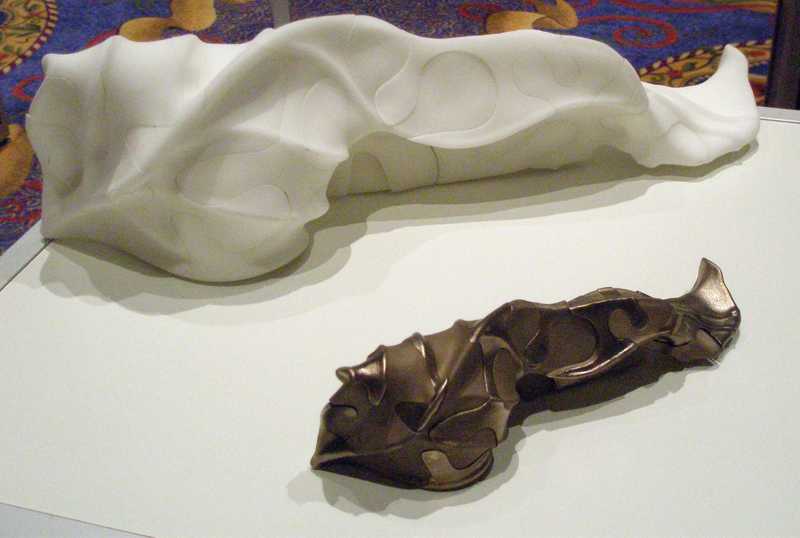
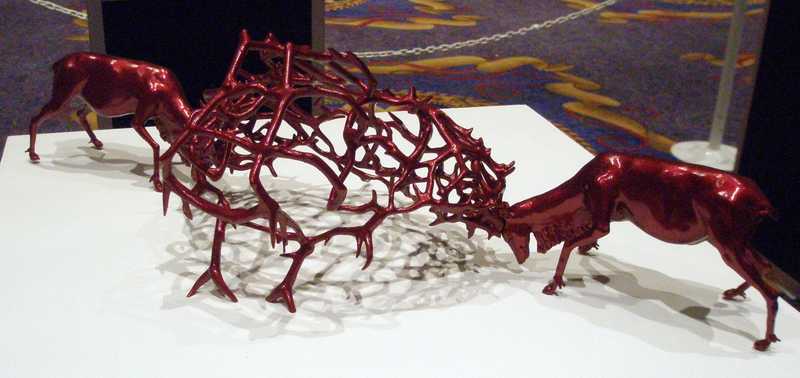
Marble sculptor Heather Ezell contributed an elegant transformation of a leaf form, while David Van Ness wove the antlers of rutting elk into a complex fractal meshwork.
Mark Grote scanned fingers and replicated them 234 times, each dyed with the blue ink used to signify voters in Afghan elections and equipped with box-cutters (for some reason). You can find out more about this interesting project here.

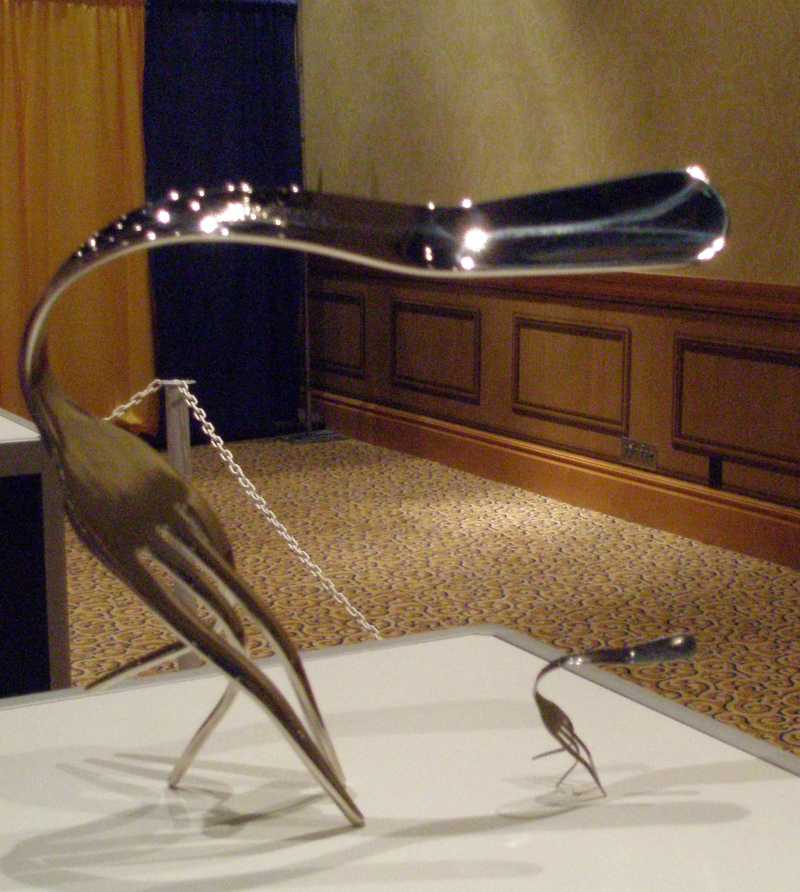
Aside from them, there was some interesting work shown by veterans of the digital sculpture movement as well. Harry Abramson of Direct Dimensions contributed a bent, scaled-up and nickel-plated fork that’s a marvel of verisimilitude. Kenneth Miller exploited the ability of the Objet machine to produce solid forms in clear resin to make a series of pieces called “Family.” I sent in “Nautivert,” a piece I made by scanning various natural forms, such as bones, shells, and mineral crystals that were combined in a virtual 3D environment, applying photographic textures based on floral images, and output on a color-capable 3D printer.

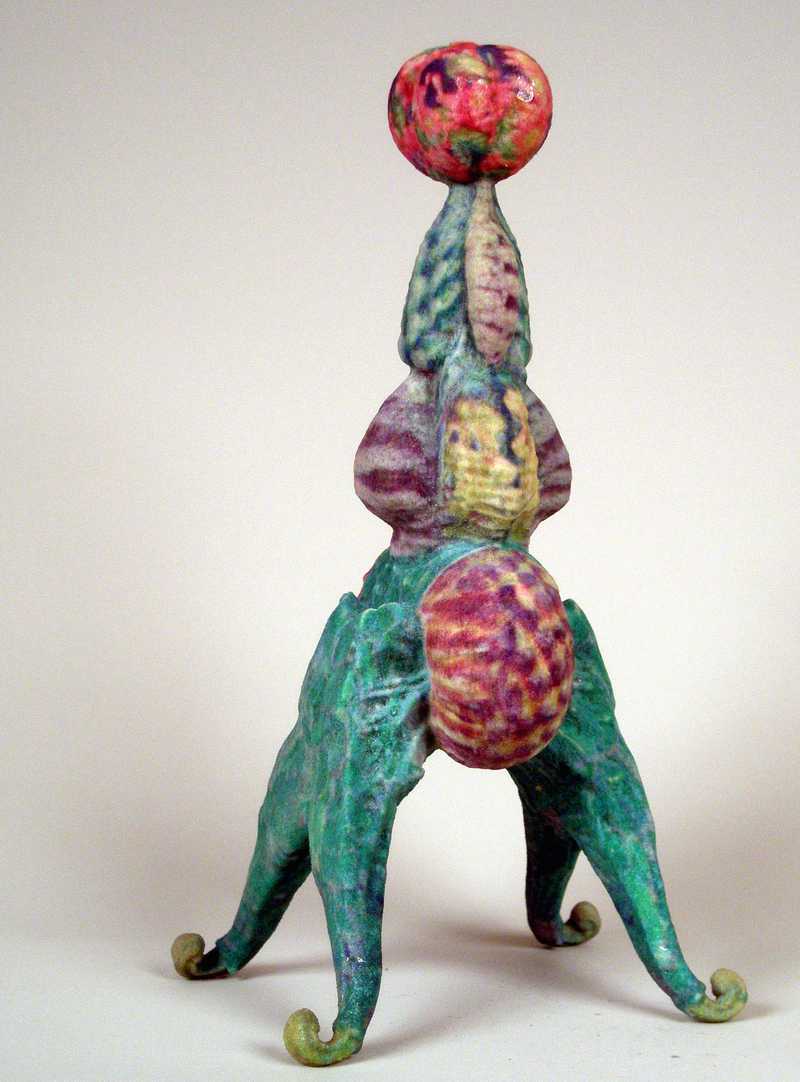
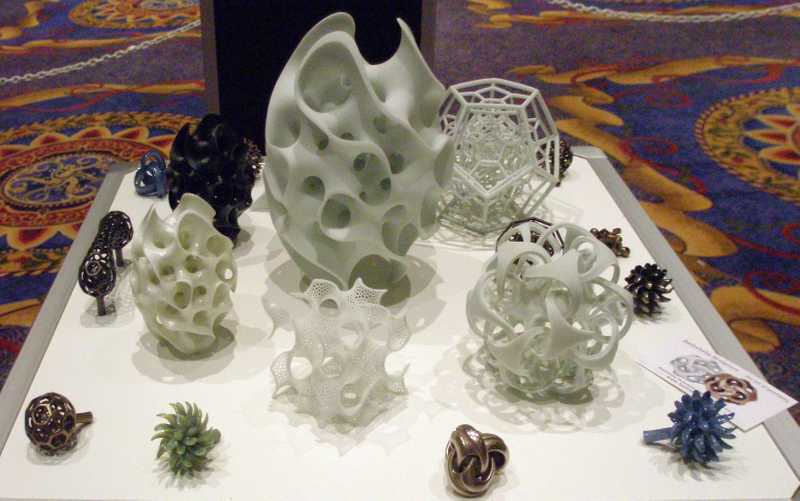
And mathematical sculptor Bathsheba Grossman, probably the closest thing to an art star the movement has produced so far (on hand for a presentation entitled “How I Quit My Day Job”), showed an array of her latest complex topologies spanning a range of media from plastic to direct metal and glass prints, the latter made by consolidating glass frit with a binder and firing it with a glaze. Just seeing the amazing results from this process close up made the trip worthwhile for me—I can’t wait to try it.
Andrew Werby